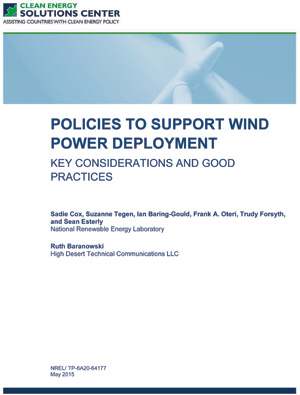Policies to Support Wind Power Deployment

The Solutions Center’s Policies to Support Wind Power Deployment: Key Considerations and Good Practices) is part of the Solutions Center’s Clean Energy Policy Briefs series.
Wind power is playing a significant role in meeting global electricity demand while also supporting local economic development, mitigation of carbon emissions, and reduction of water use from the power sector. Global wind power capacity has expanded, on average, 21% annually since 2008, with at least 85 countries having implemented commercial wind operations by 2013 (REN21 2014). As notable examples, in 2014, wind power provided 28% of electricity in Denmark (Danish Energy Association 2015), 28.5% in Iowa, United States (Iowa Wind Energy Association 2015), and 21% in Spain (RED Electrica de Espana 2014). In several countries (REN21 2014), wind power is increasingly cost-competitive with fossil fuel generation, and in some cases, it has reached wholesale costs at or below conventional generation, which is referred to as grid parity (REN21 2014). A number of energy policies have played an important role in scaling up wind deployment and increasing its economic viability, while also supporting country-specific economic, social, and environmental development goals.
Policies to support wind energy are often designed to align with broader objectives including diversification of electric generation sources to increase long-term price stability; reduction of greenhouse gas emissions and water use; and technology innovation to increase global competitiveness. Objectives specific to national and subnational contexts can provide broader framing for tailored design and implementation of wind power policies described in this paper.
Although wind power has become cost-competitive in several contexts, challenges to wind power deployment still exist. Key barriers include:
- Lack of consistent policy signals, which can create uncertainty in makers
- Unstandardized and time-consuming regulatory and permitting processes
- Concerns of utilities related to integration of distributed or variable power on the grid
- Public concern related to visual, sound, land use, and other environmental impacts that may be associated with wind
- Need for post-installation and ongoing skilled labor for turbine maintenance in developing countries.
- At high wind penetration levels and in competitive wholesale markets, potential impacts on other generation sources due to low or negative bidding.
The following summarizes the good practices and considerations for the design and implementation of wind power policies that are presented in Policies to Support Wind Power Deployment.
Policies and Good Practices
Renewable electricity standards
- Establishing long-term RES targets that increase over time to support sustained wind growth
- Defining the standard to support wind generation
- Enacting subnational RESs to support diverse wind resources and development needs
- Establishing set-asides for offshore wind technologies
- Supporting a broader enabling policy environment.
Feed-in tariffs
- Differentiating wind FIT payments in relation to resource quality
- Differentiating wind FIT payments in relation to project size
- Differentiating wind FIT payments for offshore wind development
- Differentiating wind FIT payments in relation to technology
- Considering bonus payments and premiums to support broader wind development goals
- Considering wind FIT price degression.
Interconnection standards and net metering for distributed wind
- Establishing interconnection standards
- Considering a wind net metering policy.
Wind investment and production tax credits
- Establishing an appropriate incentive rate and controlling costs
- Supporting a stable policy environment
- Determining the tax incentive period
- Wind production tax credit considerations
- Wind investment tax credit considerations
- Supporting non-taxable entities.
Further approaches to support private investment
- Identifying Competitive Renewable Energy Zones
- Reducing risk and cost of capital
- Designing wind ordinances
- Streamlining permit processes.
See Also
Wind Power Policies in Action
The following country examples provide real-world experiences and lessons learned from developing and implementing policies for enabling wind power.
- Chile: Designing a Robust Renewable Energy Policy Environment and Integrating Wind with the Energy Mix
- India: Supporting Wind Power with Tax Incentives and Ensuring Project Sustainability
- Nicaragua: Supporting Renewable Energy Deployment through Tax Incentives and a Broader Policy Framework
- Thailand: Setting Ambitious Renewable Energy and Wind Targets
- United Kingdom: Ensuring Technology Standards to Support Successful FIT Outcomes
- United States: Competitive Renewable Energy Zones and Transmission Expansion to Support Scaled-up Wind Investment
- Germany and Denmark: Supporting Wind Power through Streamlined Permitting and CREZ
